Cameron Offices to be Demolished?
A sad lesson in heritage management can be witnessed at the Cameron Offices in Canberra.
If you were told that a building listed on the Commonwealth Heritage Register was being demolished, would you believe it?
Sadly, that is exactly what is happening to Canberra’s Cameron Offices, which are considered by the Royal Australian Institute of Architects (RAIA) and the Australian Heritage Commission to be of national, if not international, architectural significance.
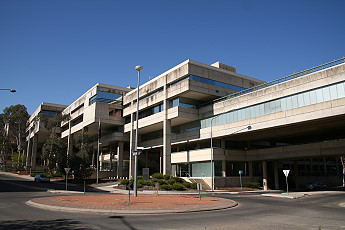
The Cameron Offices complex in Belconnen, a suburb of Canberra, is the nation’s largest example of Brutalist architecture and one of the only examples of structualism in Australia. Australian-born architect John Andrews designed the Cameron Offices in 1977 as part of a commission for the Commonwealth Government. Their construction was the initial step in the formation of the new Belconnen Town Centre and so were designed as a pedestrian-friendly and iconic contribution to the urban landscape. To this end they were a success.
The building was unique in design as well as being technically significant. Rather than construct a tall tower, Andrews designed the Cameron Offices as a series of 5-storey office wings (or ‘fingers’) with landscaped courtyards in between. A pedestrian mall linked all seven wings of the complex together. The fingers were oriented to shade the offices whilst allowing sunshine into the landscaped courtyards. Each courtyard was filled with Australian plants from around the continent. The end result was a building that was bold, innovative, iconic and very friendly to the 4000 staff that worked within its concrete walls.
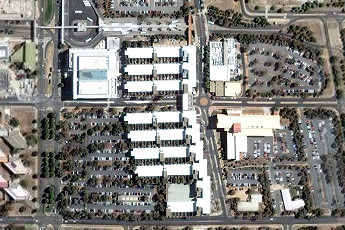
And so it was that both the Australian Heritage Commission and RAIA recognised this building’s significance. The Cameron Offices are even listed on the International Union of Architects’ World Register of Significant Twentieth Century Architecture. Unfortunately, political considerations overrode heritage concerns, and as I write, portions of this significant building are being torn down to create a car park. How was this allowed to happen?
Back in 1999, the Commonwealth Government decided that Canberra’s building and commercial office markets needed a boost. In order to achieve this, the Minister for Finance announced that the Cameron Office complex would be sold to private developers Bovis Lend Lease. The Commonwealth would receive $41 million for the offices, and Bovis Lend Lease would build new separate accommodation for the Australian Bureau of Statistics, which previously occupied the site. As a sweetner, Lend Lease would be allowed to redevelop the Cameron Offices.

At the same time, the RAIA made an approach to the Australian Heritage Commission (AHC) to include the building on the National Heritage Register. The AHC did not support the building’s inclusion and neither did the minister on appeal.
In response, the RAIA nominated the buildings for inclusion on the lower-status Commonwealth Heritage Register, which the AHC supported.
The Cameron Offices were then added to the register in August 2005. Since the AHC had not formally included the Cameron Offices sooner, the Commonwealth Department of Environment and Heritage had already given approval for developers to demolish all but wings 3 to 5 and the pedestrian bridge over Cameron Avenue. The AHC determined therefore that it could only legally protect the portion of the buildings not scheduled for demolition.
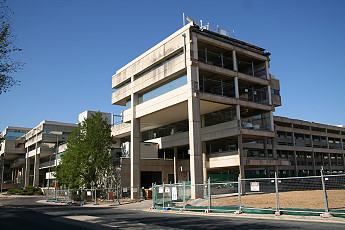
It was only at the instigation of architect John Andrews and the building’s owners that a revised development proposal was made to preserve all of the Cameron Offices, except wings 1 and 2. The gardens would also be maintained, but altered to provide the main address for what were to become apartments.
Most of the buildings have therefore been saved, but not because the government would protect them nor because the Australian Heritage Commission could. Whilst this may seem like a good outcome for all, it is disappointing that such a highly-valued heritage building could only be protected with a ‘compromise’ to demolish certain portions of it.
Visiting the Site
I was in Canberra recently, so I decided to venture out to Belconnen and take a look at the Cameron Offices for myself. Much of the complex was fenced off, but had clearly been a target of vandals. Windows were broken and graffiti could be seen in places. I was able to see the demolished portions, and the redevelopment that was occurring elsewhere. I was also able to see that the gardens were in a poor state. Nevertheless, I wanted a closer look.
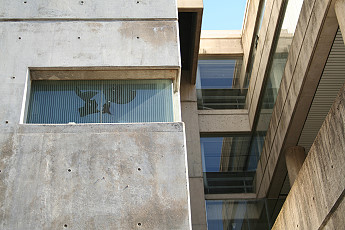
As I approached one of the Chandler Street entrances with my camera in hand, a tradesman immediately confronted me and asked what I was after. I explained my interest but the tradesman replied aggressively “I’ve seen what you people with cameras do. You get in here, take photos and publish them on the internet and criticise the development. The owners – there are four of them – have had enough of it. If you want photos, go and see the Australian Heritage Commission”.
It seemed that the building’s new private owners were only too conscious of the public interest in the Cameron Offices. They were certainly very sensitive to criticism, if the tradesperson’s attitude was anything to go by. After a small discussion about the building and my intentions towards it, I was allowed under tight supervision to inspect the gardens on condition that I take no photos of them.I was disappointed to see a number of the trees were dead and the garden had been allowed to fall into a state of ruin. However, it was confirmed to me that the gardens would be restored (including the retention of all plant species) at the completion of the redevelopment. The iconic water features and fountains would also be retained.
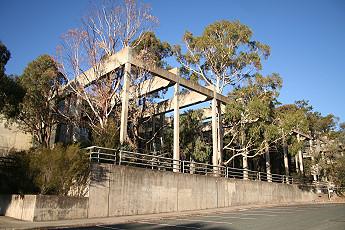
The developers cannot be blamed for demolishing and redeveloping the buildings, as it was a Commonwealth Government decision to sell the buildings and override Commonwealth heritage protection processes. Nevertheless, I believe the new owners have much to answer for in terms of protecting the building from vandalism and the noteworthy gardens from ruin. Furthermore, it was decided to completely refurbish (rather than restore) the inside (and part of the exterior) of the buildings. Whilst this obviously favours conversion to apartments, this is surely not consistent with the proper treatment of a heritage building?
The Cameron Offices are one of Australia’s best examples of 1970’s Brutalism; representing a style of architecture (and an urban ideal) unlikely to regain popularity in Australia. I can think of few other instances were a combination of partial demolition and internal refurbishment is considered proper treatment of a heritage building of national significance.
Further information:
- Apperly, R. et al (1989) A Pictorial Guide to Identifying Australian Architecture. Angus & Robertson, Sydney, NSW. p.252 (ISBN 0207 16201 8)
- Day, N. (2006) They came, they saw, they concreted. The Age, 23 January, p.14
- MacMahon, B. (2001) The Architecture of East Australia. Edition Axel Menges, Fellbach, Germany. pp.144-145 (ISBN 3930 69890 0)
- Metcalf, A. (2003) Canberra Architecture. The Watermark Press, Sydney, NSW. p.137 (ISBN 0949 28463 7).
- Trickett, G. & Dodson, M. (2006) Call to save, recognise, a precinct of integrity. The Canberra Times, 16 August, p.13
If you’d like to see the inside of the Cameron Offices, visit The RiotACT blog.
Comments
One response to “Cameron Offices to be Demolished?”
Interesting article, I currently live in the Cameron Office (one of the ‘fingers’ has been converted into university accommodation) and have grown fond of them. You’ll be glad to learn the gardens are in an immaculate state now and the water features running. Just a shame the other parts are missing.